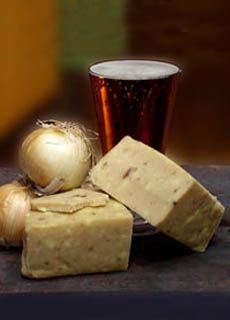TIP OF THE DAY: The Joy Of Cheddar
|
We love cheese, but cheese doesn’t love us. After a lifetime of eating it three times a day, we developed lactose intolerance—no cause and effect, just one of those things that can happen when the bloom of youth fades away.
Depending on how lactose intolerant you are, you can eat aged cheeses. The older the cheese, the more the lactose has dissipated, to just 2%, depending on the cheese. But for the truly afflicted (including us), that’s 2% too much*. The only cheese that is naturally lactose-free is Cheddar. Through the process of cheddaring†, the last bit of lactose is consumed in production. We can eat it to our heart’s delight. We always liked Cheddar, but our cheese passions lay elsewhere: blues, chèvres, double- and triple-crèmes. So we went on a Cheddar safari, first trying the dozen different Cheddars in the cheese case at Trader Joe’s. These included plain Cheddars—mild, sharp and extra-sharp—and flavored Cheddars, variously blended with bacon, chive, horseradish, jalapeño, onion, scallion, wasabi, wine/spirits and other inclusions. There’s also goat Cheddar. The king of flavored Cheddars, which we discovered elsewhere, seems to be Yancy’s Fancy of New York State, which makes some 24 flavored Cheddars, including Buffalo Wing, Grilled Bacon Cheeseburger, Pepperoni and Strawberry. One day, we’ll gather them all and have a heck of a tasting party. |
 iGourmet sells this delicious Cheddar with caramelized onions, also known as Abbot’s Gold. It’s made by Wensleydale Creamery in the U.K. Photo courtesy iGourmet. |
|
|
___________________ *Thanks to Erin Berardinelli, who wrote to tell us of mold allergy, a condition that can generate a bad reaction to the aged cheeses—as “young” as three months. If you’re reacting badly to aged cheeses but not to other dairy, have it checked out. †Cheddaring is an additional step unique to the production of Cheddar cheese. After heating, the curd is kneaded with salt, cut into cubes to drain the whey and then stacked and turned. After weeks of tasting the world of Cheddar—from Australia, Canada, New Zealand, the U.S. and the U.K.—favorites emerged. But our passion of the moment is the flavored English Cheddar With Caramelized Onions, imported by Trader Joe’s. Rich and creamy, full-bodied and redolent of the most delightful caramelized onion sweetness, it is addictive—one of those foods we call “love at first bite.” Trader Joe doesn’t disclose which Dorset producer makes this full-bodied farmhouse Cheddar, but it’s a “famed farm” with “more than 40 years of traditional cheese making experience.” The addition of caramelized onions was inspired by a classical British ploughman’s lunch pairing—cheese and chutney. The cheesemakers mixed caramelized onion marmalade into the Cheddar. The marmalade itself is made with cane sugar, cider vinegar, red currant juice, lemon juice, clove, cinnamon, sugar, ginger and olive oil. The result is a balanced sweet-savory flavor with honeyed notes and a pleasing onion aroma. The marmalade makes it a bit crumbly, like a mature Cheddar. |
||
 Our new passion: Cheddar with caramelized onions. Photo courtesy Trader Joe’s. |
HOW WE USED THE CHEDDARS Every Cheddar fan has a favorite use, often on on burgers and sandwiches, including grilled cheese. Ours is as a snack or a light meal with with a Honeycrisp apple or other fruit, or a slice or two of Dave’s Killer Bread. Given the amount of Cheddar we had on hand, we also shredded it atop casseroles, chilis and soups; made fondue and cheese sauce; served lots of cheese plates to visitors; and had it for dessert with a piece of apple pie. We also made Cheddar pizzas, variously with apple, meatball and vegetable toppings. We made Cheddar soup and cauliflower Cheddar soup. And we stuffed shredded Cheddar into grilled portabello mushroom caps, then returned them to the broiler to melt. |
|
|
A BRIEF OVERVIEW OF CHEDDAR Cheddar has been called the “cheese of kings.” Records show that in 1170, King Henry II declared Cheddar the best cheese in England, and purchased more than five tons of it. His son, Prince John, who became king in 1199, purchased a similar quantity in 1184. U.S. President Andrew Jackson (in office In 1829-1837) once held an open house party at the White House at which he served a 1,400-pound block of Cheddar. Cheddar is a hard, sharp cheese, with a paste that ranges from off-white to pale yellow to deep orange, depending on the amount of annatto added (more about that in a minute). Originating in the Somerset County village of Cheddar in southwest England, it is the most popular type of cheese in the U.K. and accounts for more than half of English cheese production. The cheese is now made worldwide, and only one producer remains in the village of Cheddar itself. The name is not protected‡ under the EU Protected Food Names program; so cheese made anywhere can be called Cheddar. However: According to Widmer Cheese, a major U.S. producer of fine Cheddar, prior to 1850 nearly all the cheese produced in the U.S. was Cheddar. Cheddar production in Wisconsin, the leader in U.S. Cheddar production, began in the mid 1800s. A yellow food coloring (annatto) was originally added to distinguish where the Cheddar was made. In the U.S., Cheddars made in the New England states traditionally retaining the natural white color. There is no difference in flavor as a result of added coloring. Aging is the only difference between mild and sharp Cheddar. The longer cheese is aged naturally, the sharper and more pronounced the Cheddar flavor becomes.
|
||


